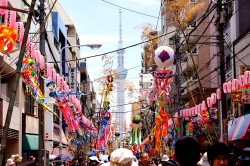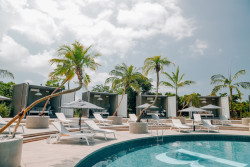
November 18, 2010
Yakushima
Nature paints the forest green on this verdant Kyushu island
By Metropolis
Originally published on metropolis.co.jp on November 2010

Photos by Kanako Hosomura
Scarred by years of exposure to the elements and partly coated in a thick cloak of dark green moss, the trunk of the cedar rises out of the forest floor and into the leaden sky. Its massive stem suddenly branches out into seven limbs, from which the 3,000-year-old tree takes its name: Nanahonsugi.
I lean back in an attempt to get a photo that does justice to this ancient wonder, just as a huge raindrop falls slowly out of the sky and onto the lens. As natural hazards go, seemingly endless rain isn’t really much of a threat to life and limb, but any visitor to Yakushima—where the locals like to remind you that it rains 35 days every month—needs to be prepared to get wet.
 Fortunately, this city slipper has been taken under the wing of Asuka Ito, one half of the husband-and-wife team that founded the Yakushima Guide Club. They’re experts in everything that the island has to offer—from diving with huge leatherneck turtles amid the coral off the west coast, to canoeing, sea kayaking, rock-climbing and hiking in the mountains. Ito got my measure at a glance, and set a pace into the Shiratani Forest that even I could cope with.
Fortunately, this city slipper has been taken under the wing of Asuka Ito, one half of the husband-and-wife team that founded the Yakushima Guide Club. They’re experts in everything that the island has to offer—from diving with huge leatherneck turtles amid the coral off the west coast, to canoeing, sea kayaking, rock-climbing and hiking in the mountains. Ito got my measure at a glance, and set a pace into the Shiratani Forest that even I could cope with.
The island’s unique warm-temperate forests are fiercely protected by the residents, who are outnumbered by visitors each year. And while many of the keener hikers tackle the more testing routes, including the climb up the 1,935m Miyanoura-dake—Kyushu’s highest peak—there are plenty of shorter jaunts to keep us amateurs busy.
The route that Ito has picked out for me today is one of a series that start from a hut below Shirataenotaki Waterfall, where adventurers pay the one-day hiking fee of ¥300. Initially, the walk is on cobbled paths and raised wooden pathways alongside the crashing waterfalls of Shiratani Creek, but after crossing the Satsuki-tsurihashi suspension bridge, things become slightly more strenuous. Though the path is still well-defined, stretches of it have ropes for walkers to hold on to, and you have to watch your step as boulders and roots try to trip the unwary.
There’s still plenty of time to admire the surroundings, however. The floor of the forest, boulders and trunks of the slow-growing trees are coated in several hundred different varieties of moss. The white rumps of deer, indifferent to our presence, bob up and down amongst the foliage. Trees grow in impossible directions, and seem to get larger the higher we climb.
The path fords small streams and clouds waft through the valley around us. The rain comes and goes. At one point, the path runs directly through the trunk of a cedar tree, which has naturally grown to have two “legs” that support it. A little way beyond the Shiratani Cabin, one of several rudimentary camps dotted throughout the mountains where hikers can spend the night, we come across the imposing Nanahonsugi. A short distance beyond that lies a rocky glen where everything is green—dubbed Princess Mononoke’s Valley, after the mysterious realm in the Hayao Miyazaki film.
After all this exercise, there’s no better way to get the kinks out of the muscles than a long session of Thai massage at the island’s newest—and most luxurious—resort. Zoning laws mean that no new hotels can be built on Yakushima, so the developers of the Sankara Hotel & Spa have completely revamped an existing property and turned it into a five-star, auberge-style facility.
 On the southern fringes of the island, new arrivals are greeted with a view from the lobby of an infinity pool stretching out to the ocean horizon. The interior combines grace with style—in everything from the suite rooms to the individual villas, spa, pool and restaurants. Such is the degree of personal attention that every guest is assigned their own butler for the entire stay. After returning from the mountains, the only dilemma is choosing whether to have a quick shower and head straight for Chef Chiharu Takei’s Okas restaurant to fix that appetite problem, or to leave yourself in the capable hands of Ryoko Ado and her herbal massages. Your call.
On the southern fringes of the island, new arrivals are greeted with a view from the lobby of an infinity pool stretching out to the ocean horizon. The interior combines grace with style—in everything from the suite rooms to the individual villas, spa, pool and restaurants. Such is the degree of personal attention that every guest is assigned their own butler for the entire stay. After returning from the mountains, the only dilemma is choosing whether to have a quick shower and head straight for Chef Chiharu Takei’s Okas restaurant to fix that appetite problem, or to leave yourself in the capable hands of Ryoko Ado and her herbal massages. Your call.
Trip Tips
Japan Air Commuter, a subsidiary of JAL, operates five 30-minute flights every day from Kagoshima airport to Yakushima. Kagoshima itself is served by regular JAL flights from Haneda airport. The Yakushima Guide Club (tel: 0997-46-3160; www.yakushima-guide.jp) has a wide variety of activity tours available. Reservations at the Sankara Hotel & Spa Yakushima can be made via its website at http://sankarahotel-spa.com/en/

-390x250.jpg)





